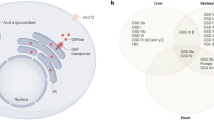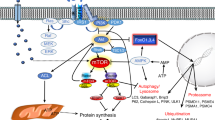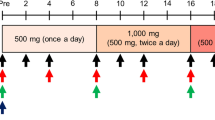Key Points
-
Of the glycogenolytic and glycolytic disorders (GSDs), McArdle disease (GSD V) is the most common (prevalence 1 in 100,000–167,000), and β-enolase deficiency is the rarest, with only three cases identified to date
-
The GSDs result from autosomal or X-linked recessive mutations, resulting in a specific enzyme deficiency that leads to the inability to utilize muscle glycogen as an energy substrate
-
The main features of the GSDs include exercise intolerance, hyperCKaemia and myoglobinuria; paradoxically, when appropriately prescribed, exercise can improve work capacity, reduce health risks, ameliorate symptoms and improve quality of life
-
Exercise intolerance and, hence, avoidance can lead to secondary health threats from a sedentary lifestyle, increase health risks generally, and further impair quality of life
-
Additional clinical features, such as dysmorphic features, haemolysis, neurological features, liver disease, skin lesions and/or cardiomyopathy, can help to pinpoint the specific enzyme deficiency
-
Potential therapies for McArdle disease are being explored through the use of animal models of the disease (cattle, sheep and mice), and through dietary manipulation and speculative drug therapy in humans
-
A European database (EUROMAC) has been established to pool and transfer knowledge regarding McArdle disease and other rare diseases of carbohydrate metabolism more effectively
Abstract
Skeletal muscle disorders of glycogenolysis and glycolysis account for most of the conditions collectively termed glycogen storage diseases (GSDs). These disorders are rare (incidence 1 in 20,000–43,000 live births), and are caused by autosomal or X-linked recessive mutations that result in a specific enzyme deficiency, leading to the inability to utilize muscle glycogen as an energy substrate. McArdle disease (GSD V) is the most common of these disorders, and is caused by mutations in the gene encoding muscle glycogen phosphorylase. Symptoms of McArdle disease and most other related GSDs include exercise intolerance, muscle contracture, acute rhabdomyolysis, and risk of acute renal failure. Older patients may exhibit muscle wasting and weakness involving the paraspinal muscles and shoulder girdle. For patients with these conditions, engaging with exercise is likely to be beneficial. Diagnosis is frequently delayed owing to the rarity of the conditions and lack of access to appropriate investigations. A few randomized clinical trials have been conducted, some focusing on dietary modification, although the quality of the evidence is low and no specific recommendations can yet be made. The development of EUROMAC, an international registry for these disorders, should improve our knowledge of their natural histories and provide a platform for future clinical trials.
This is a preview of subscription content, access via your institution
Access options
Subscribe to this journal
Receive 12 print issues and online access
$209.00 per year
only $17.42 per issue
Buy this article
- Purchase on Springer Link
- Instant access to full article PDF
Prices may be subject to local taxes which are calculated during checkout




Similar content being viewed by others
References
Ozen, H. Glycogen storage diseases: new perspectives. World J. Gastroenterol. 13, 2541–2553 (2007).
Boustany, R.-M. Lysosomal storage diseases — the horizon expands. Nat. Rev. Neurol. 9, 583–598 (2013).
Levine, J. A. Non-exercise activity thermogenesis. Proc. Nutr. Soc. 62, 667–679 (2003).
Quinlivan, R. et al. McArdle disease: a clinical review. J. Neurol. Neurosurg. Psychiatry 81, 1182–1188 (2010).
Preisler, N., Haller, R. G. & Vissing, J. Exercise in muscle glycogen storage diseases. J. Inherit. Metab. Dis. 38, 551–563 (2015).
McArdle, B. Myopathy due to a defect in muscle glycogen breakdown. Clin. Sci. 10, 13–35 (1951).
Tsujino, S., Shanske, S. & DiMauro, S. Molecular genetic heterogeneity of myophosphorylase deficiency (McArdle disease). N. Engl. J. Med. 329, 241–245 (1993).
Nogales-Gadea, G. et al. McArdle disease: update of reported mutations and polymorphisms in the PYGM gene. Hum. Mutat. 36, 669–678 (2015).
DeCastro, M., Johnston, J. & Biesecker, L. Determining the prevalence of McArdle disease from gene frequency by analysis of next-generation sequencing data. Genet. Med. 17, 1002–1006 (2015).
Lucia, A. et al. Genotypic and phenotypic features of McArdle disease: insights from the Spanish national registry. J. Neurol. Neurosurg. Psychiatry 83, 322–328 (2012).
Vissing, J., Duno, M., Schwartz, M. & Haller, R. G. Splice mutations preserve myophosphorylase activity that ameliorates the phenotype in McArdle disease. Brain 132, 1545–1552 (2009).
McArdle, W. D., Katch, F. I. & Katch, V. L. Essentials of Exercise Physiology 2nd edn (Lippincott Williams & Wilkins, 2000).
Dubowitz, V., Sewry, A. & Oldfors, A. Muscle Biopsy: A Practical Approach 4th edn (Saunders Ltd, 2013).
Cristina Pacheco, M., Miles, L. & Bove, K. E. False negative histochemical reaction for myophosphorylase activity in fulminant sepsis due to methicillin resistant Staphylococcus aureus. Neuromuscul. Disord. 17, 983–985 (2007).
Huxley, H. & Hanson, J. Changes in the cross-striations of muscle during contraction and stretch and their structural interpretation. Nature 173, 973–976 (1954).
Huxley, A. F. & Neidergerke, R. Structural changes in muscle during contraction; interference microscopy of living muscle fibres. Nature 173, 971–973 (1954).
Pearson, C. M., Rimer, D. G. & Mommaerts, W. F. A metabolic myopathy due to absence of muscle phosphorylase. Am. J. Med. 30, 502–517 (1961).
Vissing, J. & Haller, R. G. A diagnostic cycle test for McArdle's disease. Ann. Neurol. 54, 539–542 (2003).
Gladden, L. B. Muscle as a consumer of lactate. Med. Sci. Sports Exerc. 32, 764–771 (2000).
Donovan, C. M. & Pagliassotti, M. J. Quantitative assessment of pathways for lactate disposal in skeletal muscle fiber types. Med. Sci. Sports Exerc. 32, 772–777 (2000).
Gruener, R., McArdle, B., Ryman, B. E. & Weller, R. O. Contracture of phosphorylase deficient muscle. J. Neurol. Neurosurg. Psychiatry 31, 268–283 (1968).
Buckley, J. P., Quinlivan, R. M., Sim, J., Eston, R. G. & Short, D. S. Heart rate and perceived pain responses to a functional walking test in McArdle disease. J. Sports Sci. 32, 1561–1569 (2014).
Borg, G. Borg's Perceived Exertion and Pain Scales (Human Kinetics, 1998).
Department of Health. Start active, stay active: report on physical activity in the UK. GOV. UK https://www.gov.uk/government/publications/start-active-stay-active-a-report-on-physical-activity-from-the-four-home-countries-chief-medical-officers (2011).
Garber, C. E. et al. American College of Sports Medicine position stand. Quantity and quality of exercise for developing and maintaining cardiorespiratory, musculoskeletal and neuromotor fitness in apparently healthy adults: guidance for prescribing exercise. Med. Sci. Sports Exerc. 43, 1334–1359 (2011).
Blair, S. N. et al. Physical fitness and all-cause mortality. A prospective study of healthy men and women. JAMA 262, 2395–2401 (1989).
Kodama, S. et al. Cardiorespiratory fitness as a quantitative predictor of all-cause mortality and cardiovascular events in healthy men and women: a meta-analysis. JAMA 301, 2024–2035 (2009).
Kavanagh, T. et al. Prediction of long-term prognosis in 12 169 men referred for cardiac rehabilitation. Circulation 106, 666–671 (2002).
Kavanagh, T. et al. Peak oxygen intake and cardiac mortality in women referred for cardiac rehabilitation. J. Am. Coll. Cardiol. 42, 2139–2143 (2003).
Myers, J., Prakash, M., Froelicher, V., Partington, S. & Atwood, J. E. Exercise capacity and mortality among men referred for exercise testing. N. Engl. J. Med. 346, 793–801 (2002).
Babraj, J. A. et al. Extremely short duration high intensity interval training substantially improves insulin action in young males. BMC Endocr. Disord. 9, 3 (2009).
Hansen, D. et al. Continuous low- to moderate-intensity exercise training is as effective as moderate- to high-intensity exercise at lowering blood HbA1c in obese type 2 diabetes patients. Diabetologia 52, 1789–1797 (2009).
Musa, D. I., Adeniran, S. A., Dikko, A. U. & Sayers, S. P. The effect of a high-intensity interval training program on high-density lipoprotein cholesterol in young men. J. Strength Cond. Res. 23, 587–592 (2009).
Tsekouras, Y. E. et al. High-intensity interval aerobic training reduces hepatic very low-density lipoprotein-triglyceride secretion rate in men. Am. J. Physiol. Endocrinol. Metab. 295, E851–E858 (2008).
Burgomaster, K. A. et al. Divergent response of metabolite transport proteins in human skeletal muscle after sprint interval training and detraining. Am. J. Physiol. Regul. Integr. Comp. Physiol. 292, R1970–R1976 (2007).
Talanian, J. L. et al. Exercise training increases sarcolemmal and mitochondrial fatty acid transport proteins in human skeletal muscle. Am. J. Physiol. Endocrinol. Metab. 299, E180–E188 (2010).
Munguía-Izquierdo, D., Santalla, A. & Lucia, A. Cardiorespiratory fitness, physical activity and quality of life in patients with McArdle disease. Med. Sci. Sports Exerc. 47, 799–808 (2015).
Haller, R. G., Wyrick, P., Taivassalo, T. & Vissing, J. Aerobic conditioning: an effective therapy in McArdle's disease. Ann. Neurol. 59, 922–928 (2006).
García-Benítez, S., Fleck, S. J., Naclerio, F., Martín, M. A. & Lucia, A. Resistance (weight lifting) training in an adolescent with McArdle disease. J. Child Neurol. 28, 805–808 (2013).
Santalla, A. et al. Feasibility of resistance training in adult McArdle patients: clinical outcomes and muscle strength and mass benefits. Front. Aging Neurosci. 6, 334 (2014).
Kley, R. A., Tarnopolsky, M. A. & Vorgerd, M. Creatine for treating muscle disorders. Cochrane Database Syst. Rev. 6, CD004760 (2013).
Quinlivan, R., Martinuzzi, A. & Schoser, B. Pharmacological and nutritional treatment for McArdle disease (Glycogen Storage Disease type V). Cochrane Database Syst. Rev. 11, CD003458 (2014).
Vissing, J. & Haller, R. G. The effect of oral sucrose on exercise tolerance in patients with McArdle's disease. N. Engl. J. Med. 349, 2503–2509 (2003).
Lucia, A. et al. McArdle disease: what do neurologists need to know? Nat. Clin. Pract. Neurol. 4, 568–577 (2008).
Andersen, S. T., Haller, R. G. & Vissing, J. Effect of oral sucrose shortly before exercise on work capacity in McArdle disease. Arch. Neurol. 65, 786–789 (2008).
Ørngreen, M. C. et al. Fat metabolism during exercise in patients with McArdle disease. Neurology 72, 718–724 (2009).
Vorgerd, M. & Zange, J. Treatment of glycogenosis type V (McArdle disease) with creatine and ketogenic diet with clinical scores and with 31P-MRS on working leg muscle. Acta Myol. 26, 61–63 (2007).
Nogales-Gadea, G. et al. Knock-in mice for R50X mutation in the PYGM gene present with McArdle disease. Brain 135, 2048–2057 (2012).
Howell, J. M. et al. Phosphorylase re-expression, increase in the force of contraction and decreased fatigue following notexin-induced muscle damage and regeneration in the ovine model of McArdle disease. Neuromuscul. Disord. 24, 167–177 (2014).
Howell, J. M., Dunton, E., Creed, K. E., Quinlivan, R. & Sewry, C. Investigating sodium valproate as a treatment for McArdle disease in sheep. Neuromuscul. Disord. 25, 111–119 (2015).
Shen, J. et al. Mutations in exon 3 of the glycogen debranching enzyme gene are associated with glycogen storage disease type III that is differentially expressed in liver and muscle. J. Clin. Invest. 98, 352–357 (1996).
Endo, Y. et al. Molecular analysis of the AGL gene: heterogeneity of mutations in patients with glycogen storage disease type III from Germany, Canada, Afghanistan, Iran, and Turkey. J. Hum. Genet. 51, 958–963 (2006).
Van Hoof, F. & Hers, H. G. The subgroups of type III glycogenosis. Eur. J. Biochem. 2, 265–270 (1967).
Ding, J.-H., de Barsy, T., Brown, B. I., Coleman, R. A. & Chen, Y.-T. Immunoblot analyses of glycogen debranching enzyme in different subtypes of glycogen storage disease type III. J. Pediatr. 116, 95–100 (1990).
Kishnani, P. S. et al. Glycogen storage disease type III diagnosis and management guidelines. Genet. Med. 12, 446–463 (2010).
Preisler, N. et al. Exercise intolerance in glycogen storage disease type III: weakness or energy deficiency. Mol. Genet. Metab. 109, 14–20 (2013).
Preisler, N. et al. Skeletal muscle metabolism is impaired during exercise in glycogen storage disease type III. Neurology 84, 1767–1771 (2015).
Wary, C. et al. Investigating glycogenosis type III with multi-parametric functional NMR imaging and spectroscopy. Neuromuscul. Disord. 20, 548–558 (2010).
Tarui, S. et al. Phosphofructokinase deficiency in skeletal muscle. A new type of glycogenosis. Biochem. Biophys. Res. Commun. 19, 517–523 (1965).
Vora, S., Seaman, C., Durham, S. & Piomelli, S. Isoenzymes of human phosphofructokinase: identification and subunit structural characterization of a new system. Proc. Natl Acad. Sci. USA 77, 62–66 (1980).
Toscano, A. & Musumeci, O. Tarui disease and distal glycogenosis: clinical and genetic update. Acta Myol. 26, 105–107 (2007).
Ronquist, G., Rudolphi, O., Engström, I. & Waldenström, A. Familial phosphofructokinase deficiency is associated with a disturbed calcium homeostasis in erythrocytes. J. Intern. Med. 240, 85–95 (2001).
DiMauro, S. & Garone, C. Metabolic disorders of fetal life: glycogenoses and mitochondrial defects of the respiratory chain. Semin. Fetal Neonatal Med. 16, 181–189 (2011).
Sherman, J. B. et al. Common mutations in the phosphofructokinase-M gene Ashkenazi Jewish patients with glycogenesis VII — and their population frequency. Am. J. Hum. Genet. 55, 305–313 (1994).
Smith, B. F. et al. Molecular basis of canine muscle type phosphofructokinase deficiency. J. Biol. Chem. 27, 20070–20074 (1996).
Maichele, A. J., Burwinkel, B., Maire, I., Søvik, O. & Kilimann, M. W. Mutations in the testis/liver isoform of the phosphorylase kinase γ subunit (PHKG2) cause autosomal liver glycogenosis in gsd rat and in humans. Nat. Genet. 14, 337–340 (1996).
Hug, G., Schubert, W. K. & Chuck, G. Phosphorylase kinase of the liver: deficiency in a girl with increased hepatic glycogen. Science 153, 1534–1535 (1966).
Beauchamp, N. J. et al. Glycogen storage disease type IX: high variability in clinical phenotype. Mol. Genet. Metab. 92, 88–99 (2007).
Lyon, M. F. Gene action in the X-chromosome of the mouse (Mus musculus L.). Nature 190, 372–373 (1961).
Bali, D. S. et al. Variability of disease spectrum in children with liver phosphorylase kinase deficiency caused by mutations in the PHKG2 gene. Mol. Genet. Metab. 111, 309–313 (2014).
Chen, Y.-T. Kishnani, P. S. & Koeberl, D. Glycogen storage diseases. The Online Metabolic and Molecular Bases of Inherited Disease http://ommbid.mhmedical.com/content.aspx?bookid=971§ionid=62672129 (2009).
Comi, G. P. et al. β-enolase deficiency, a new metabolic myopathy of distal glycolysis. Ann. Neurol. 50, 202–207 (2001).
Musumeci, O. et al. Recurrent rhabdomyolysis due to muscle β-enolase deficiency: very rare or underestimated. J. Neurol. 261, 2424–2428 (2014).
Chen, S.-H. & Giblett, E. R. Enolase: human tissue distribution and evidence for three different loci. Ann. Hum. Genet. 39, 277–280 (1976).
Stojkovic, T. et al. Muscle glycogenosis due to phosphoglucomutase 1 deficiency. N. Engl. J. Med. 361, 425–427 (2009).
Tegtmeyer, L. C. et al. Multiple phenotypes in phosphoglucomutase 1 deficiency. N. Engl. J. Med. 370, 533–542 (2014).
Morava, E. Galactose supplementation in phosphoglucomutase-1 deficiency; review and outlook for a novel treatable CDG. Mol. Genet. Metab. 112, 275–279 (2014).
Salameh, J., Goyal, N., Choudry, R., Camelo-Piragua, S. & Chong, P. S. Phosphoglycerate mutase deficiency with tubular aggregates in a patient from Panama. Muscle Nerve 47, 138–140 (2013).
Oh, S. J. et al. Exercise-induced cramp, myoglobinuria, and tubular aggregates in phosphoglycerate mutase deficiency. Muscle Nerve 34, 572–576 (2006).
Tsujino, S., Shanske, S., Sakoda, S., Toscano, A. & DiMauro, S. Molecular genetic studies in muscle phosphoglycerate mutase (PGAM-M) deficiency. Muscle Nerve Suppl. 3, S50–S53 (1995).
Tonin, P. et al. Unusual presentation of phosphoglycerate mutase deficiency due to two different mutations in PGAM-M gene. Neuromuscul. Disord. 19, 776–778 (2009).
Fujii, H. & Miwa, S. Other erythrocyte enzyme deficiencies associated with non-haematological symptoms: phosphoglycerate kinase and phosphofructokinase deficiency. Baillieres Best Pract. Res. Clin. Haematol. 13, 141–148 (2000).
Spiegel, R. et al. Myopathic form of phosphoglycerate kinase (PGK) deficiency: a new case and pathogenic considerations. Neuromuscul. Disord. 19, 207–211 (2009).
Sotiriou, E., Greene, P., Krishna, S., Hirano, M. & DiMauro, S. Myopathy and parkinsonism in phosphoglycerate kinase deficiency. Muscle Nerve 41, 707–710 (2010).
Tamai, M. et al. Phosphoglycerate kinase deficiency due to a novel mutation (c. 1180A>G) manifesting as chronic hemolytic anemia in a Japanese boy. Int. J. Hematol. 100, 393–397 (2014).
Miyajima, H., Takahashi, Y. & Kaneko, E. Characterization of the oxidative metabolism in lactate dehydrogenase A deficiency. Intern. Med. 34, 502–506 (1995).
Kanno, T. & Maekawa, M. Lactate dehydrogenase M-subunit deficiencies: clinical features, metabolic background, and genetic heterogeneities. Muscle Nerve Suppl. 3, S54–S60 (1995).
Hidaka, K. et al. First case of missense mutation (LDH-H:R171P) in exon 4 of the lactate dehydrogenase gene detected in a Japanese patient. J. Hum. Genet. 44, 69–72 (1999).
Akman, H. et al. Late-onset polyglucosan body myopathy in five patients with a homozygous mutation in GYG1. Neuromuscul. Disord. 26, 16–20 (2016).
Sukigara, S. et al. Muscle glycogen storage disease 0 presenting recurrent syncope with weakness and myalgia. Neuromuscul. Disord. 22, 162–165 (2012).
Malfatti, E. et al. A new muscle glycogen storage disease associated with glycogenin-1 deficiency. Ann. Neurol. 76, 891–898 (2014).
Nilsson, J. et al. Polyglucosan body myopathy caused by defective ubiquitin ligase RBCK1. Ann. Neurol. 74, 914–919 (2013).
Kollberg, G. et al. Cardiomyopathy and exercise intolerance in muscle glycogen storage disease 0. N. Engl. J. Med. 11, 1507–1514 (2007).
Hedberg-Oldfors, C. & Oldfors, A. Polyglucosan storage myopathies. Mol. Aspects Med. 46, 85–100 (2015).
Quinlivan, R. et al. Report on the EUROMAC McArdle testing exercise workshop. Madrid, Spain, 11–12 July 2014. Neuromuscul. Disord. 25, 739–745 (2015).
Acknowledgements
We wish to acknowledge the European Union for funding the EUROMAC network and NHS England for funding our nationally commissioned service. We wish to thank the Association for Glycogen Storage Disease UK (AGSD-UK) for their continuing support, as well as Muscular Dystrophy UK (MDUK), which is currently funding a trial of valproate in McArdle disease.
Author information
Authors and Affiliations
Contributions
Both authors researched data for the article, made substantial contributions to discussions of the content, wrote the article, and reviewed and edited the manuscript before submission.
Corresponding author
Ethics declarations
Competing interests
The authors declare no competing financial interests.
Related links
FURTHER INFORMATION
Rights and permissions
About this article
Cite this article
Godfrey, R., Quinlivan, R. Skeletal muscle disorders of glycogenolysis and glycolysis. Nat Rev Neurol 12, 393–402 (2016). https://doi.org/10.1038/nrneurol.2016.75
Published:
Issue Date:
DOI: https://doi.org/10.1038/nrneurol.2016.75
This article is cited by
-
Muscle diffusion tensor imaging in glycogen storage disease V (McArdle disease)
European Radiology (2019)
-
A double‐blind, placebo‐controlled trial of triheptanoin in adult polyglucosan body disease and open‐label, long‐term outcome
Journal of Inherited Metabolic Disease (2018)
-
The histone code reader Spin1 controls skeletal muscle development
Cell Death & Disease (2017)



